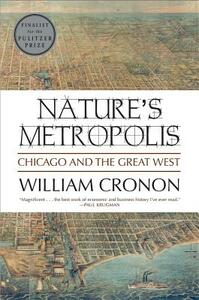You need to sign in or sign up before continuing.
Take a photo of a barcode or cover
The middle section, especially the sections on the start of the Board of Trade and the meat packing trade were absolutely fascinating. The book as a whole was a touch long and dry, and the prologue in particular seemed a bit self indulgent.
Still, worth reading (or listening to the audiobook) for history buffs with an interest in Chicago.
Still, worth reading (or listening to the audiobook) for history buffs with an interest in Chicago.
This was a really great, engaging read that is essentially 380 words on a simple theme: Chicago didn't grow on nothing but other people's debt.
It's a classic and you don't need me to suggest it, but as much as Nature's Metropolis is about Chicago, it's also about the 19th-century American city, or cities writ-large. Infrastructure that connects the rural and the urban also creates opportunities and it also creates suckers. The second runs off of the third.
Cronon does a great job going through this in meticulous detail. His debt maps are remarkable pieces of scholarship, all the more so for being done in the early 1990s. The book is incredibly readable and full of anecdotes that improve the story instead of distract from it. This is great scholarship and a fascinating read.
It's a classic and you don't need me to suggest it, but as much as Nature's Metropolis is about Chicago, it's also about the 19th-century American city, or cities writ-large. Infrastructure that connects the rural and the urban also creates opportunities and it also creates suckers. The second runs off of the third.
Cronon does a great job going through this in meticulous detail. His debt maps are remarkable pieces of scholarship, all the more so for being done in the early 1990s. The book is incredibly readable and full of anecdotes that improve the story instead of distract from it. This is great scholarship and a fascinating read.
This is quite a different book than what I've read before. It is more of a book written from the perspective of an economist than from a typical historian. A different approach that takes some time getting used to. I started reading it once and couldn't finish it at the time because I had a hard time following what the author was saying. Started a second time much later and was able to finish and it got better by the end. It is very thought provoking and forces you to think about your place within the city/country dichotomy. In our modern society, we don't really think about where our food and other material goods come from, in contrast to life in the 1800's where people made everything that they consumed. The premise of this book is that the rise and history of Chicago illustrates the change from the older pastoral life styles we used to live and what made it possible for the modern life styles we now enjoy. It takes a while to get to that point in the closing chapters but once I got there, all the previous chapters made a lot more sense and I could see how the author was using the different approach to really make the point. I was expecting more of a general history of Chicago, which is not what this book is about.
informative
slow-paced
A well-researched economic history of the city of Chicago and its hinterlands.
This book illustrates the interdependent relationship between urban and rural areas through case studies of Chicago’s commodities trade: corn, grain, lumber, and meat.
Highly recommend if you are a fan of the city of Chicago, if you’re interested in economics, or if you love a good illustrative chart or map. Some amazing exhibits in here!
It also helped me understand the mutual dependence and distrust between urban and rural populations, which has been a signature of American culture for as long as we’ve had cities.
This book illustrates the interdependent relationship between urban and rural areas through case studies of Chicago’s commodities trade: corn, grain, lumber, and meat.
Highly recommend if you are a fan of the city of Chicago, if you’re interested in economics, or if you love a good illustrative chart or map. Some amazing exhibits in here!
It also helped me understand the mutual dependence and distrust between urban and rural populations, which has been a signature of American culture for as long as we’ve had cities.
informative
reflective
medium-paced
In all of the books I’ve read about Chicago (2) this definitely ranks last. Needs more murder and less cow intestines in my opinion.
informative
slow-paced
Living in Chicago, I never quite understood what made it one of the fastest growing cities of the 19th century, growing from 200 people when it was founded in 1833 to the 5th-largest city in the world at the end of the century. Cronon does an excellent job of explaining the economics and the industries that drove that growth, and in the last chapters, suggests where this success fed into Chicago's late 20th-century decline.
challenging
informative
reflective
slow-paced


